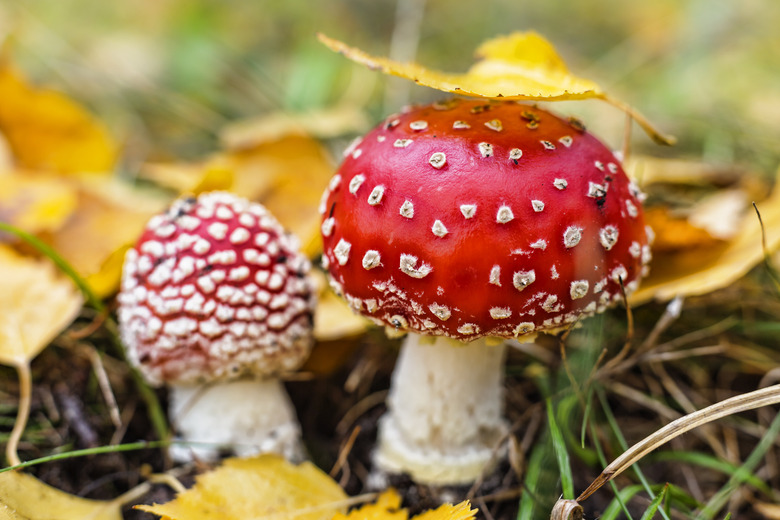How To Identify Wild Mushrooms In Florida
The best way to identify a Florida mushroom you can eat is to start with the indigo milk cap, Lactarius indigo, which is a blue mushroom species. Pluck the mushroom from the ground, turn it over and run the tip of a pocketknife perpendicular to its fluted gills or ridges close to the mushroom's stalk. If you have the right mushroom, it should bleed a deep blue milk. Another easily identifiable mushroom for novice foragers is the chanterelles mushroom, Cantharellus cibarius, which looks like a striking yellow-orange or apricot flower set against the backdrop of a dreary autumn forest. Chanterelles mushrooms have a slight fruity fragrance.
TL;DR (Too Long; Didn't Read)
**Florida University warns novice mushroomers to never eat a mushroom that is unidentifiable**. As fungi, mushrooms typically grow on decaying organic matter. With over 14,000 edible and non-edible species in the country, some mushrooms can cause death when eaten. If you're uncertain, compare the foraged mushroom with pictures online, check the images against those in a Florida mushroom book, or take the mushroom to a professional for identification. If you can't identify it as safe, then just don't eat it.
Identifying Mushrooms
Identifying Mushrooms
Take care when selecting mushrooms to eat because most edible mushrooms have non-edible and even poisonous lookalikes. When examining mushrooms, carefully inspect all the mushroom's parts, as this helps to further identify edible vs. non-edible species:
- Body Shape: The
mushroom's body often determines its species. Notice whether the mushroom has a cap at a 90-degree angle to the stalk, looks like a flower or a big round ball.
- Cap: The part at the
top of the stalk which looks like a hat or an umbrella is the cap. Note its width, shape and color.
- Underside of Cap: The underside
of the cap may contain pores, spines, gill-like ridges or tubes. Note distinctive features such as spacing, color and stripe attachment. Also check for a veil that covers the gills beneath the cap.
- Stem: The pillar-like
column on which the cap sits. Check for stripes, striations or other identifying features such as rings or bulbous protrusions.
- Substrate: Identify
where and on what the mushroom grows. Check if it grows on leaves, old logs, wood chips, directly on soil or on animal dung.
- Season: Mushrooms
grow at different times of the year. Verifying when the mushroom grows can go a long way to determining whether it's safe to eat or not.
Edible Mushrooms
Edible Mushrooms
Other easy-to-identify Florida mushrooms include mushrooms from the Boletaceae family such as the King Boletus or Porcini mushroom. As a common edible mushroom, these mushrooms have a mildly nutty taste, grow in the early fall or spring and show up in fir, spruce or pine forests. Tops are medium-to-large sized with a brownish-red, brown or tan caps. Instead of gills on the underside of the cap, boletus look spongy-like with small pores that release spores. Young mushrooms have whitish spores which mature to a yellow-olive color. They have thick stalks, often with a bulb near the ground that tapers toward the top beneath the cap.
Poisonous Mushrooms
Poisonous Mushrooms
To avoid collecting mushrooms that may be poisonous make note:
- Don't pick mushrooms with white gills, a skirt or ring on the stalk or a sack-like base known as a volva at the bottom of the stem. While some edible mushrooms do have these features,
there are deadly versions, like the mushrooms in the Amanita family, that can result in death.
- **Avoid mushrooms that have red stalks or caps.** Again, there are edible versions of mushrooms
with these features, but there are also very poisonous ones.
- **Never eat a mushroom you're not 100 percent certain that is safe to eat. If you have
questions about its safety after checking the mushroom against pictures in books or online, don't eat it.
Cite This Article
MLA
Brenner, Laurie. "How To Identify Wild Mushrooms In Florida" sciencing.com, https://www.sciencing.com/identify-wild-mushrooms-florida-6329232/. 17 April 2018.
APA
Brenner, Laurie. (2018, April 17). How To Identify Wild Mushrooms In Florida. sciencing.com. Retrieved from https://www.sciencing.com/identify-wild-mushrooms-florida-6329232/
Chicago
Brenner, Laurie. How To Identify Wild Mushrooms In Florida last modified March 24, 2022. https://www.sciencing.com/identify-wild-mushrooms-florida-6329232/
